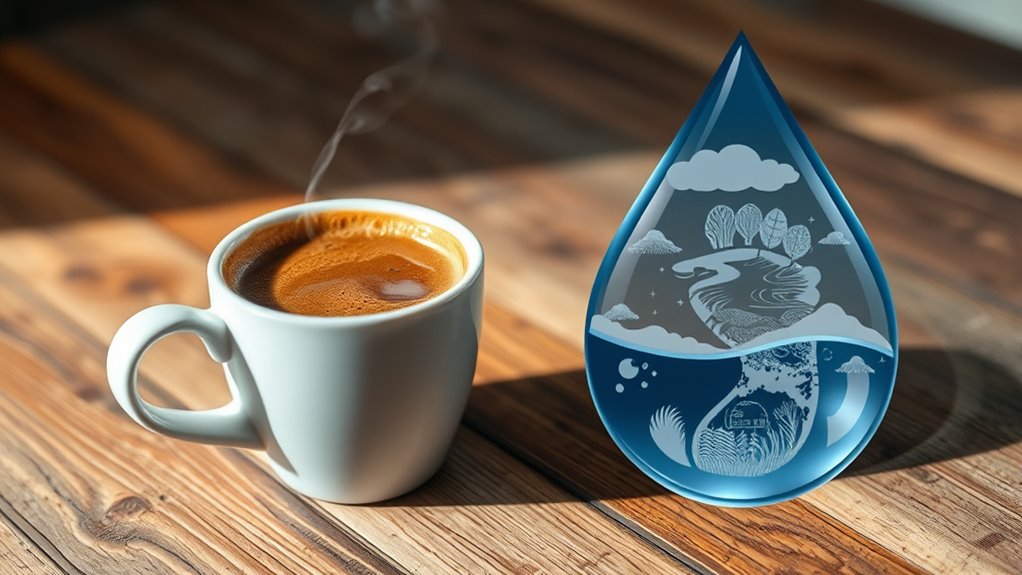The water footprint of a cup of coffee includes all the water used during its lifecycle, from growing the beans through processing and equipment cleaning. This means it’s not just the water you see in your mug, but also irrigation, harvesting, and manufacturing. By understanding these numbers, you can see how much effort goes into each cup. Keep exploring to discover how sustainable practices can help reduce this significant water impact.
Key Takeaways
- The water footprint of a coffee cup includes water used throughout cultivation, processing, and equipment cleaning, not just brewing.
- On average, a single cup of coffee requires about 140 liters of water, reflecting the entire lifecycle of production.
- Water-saving practices like drip irrigation and rainwater harvesting significantly reduce the overall water footprint.
- Sustainable farming methods can lower water use and protect local water sources and ecosystems.
- Understanding these numbers encourages consumers and industry to support responsible water management and conservation efforts.

Have you ever wondered how much water goes into making your morning coffee? The answer might surprise you, especially when you consider the intricate processes involved in growing, harvesting, and processing coffee beans. The water footprint of a single cup isn’t just about the amount of water used to brew it; it encompasses everything from the irrigation of coffee plants to the cleaning of equipment. One way to reduce this impact is through sustainable farming practices. Coffee farmers implementing sustainable farming prioritize water conservation techniques, which help minimize water usage and protect local water sources. These methods include drip irrigation, which delivers water directly to the roots, and rainwater harvesting, capturing natural rainfall to irrigate crops. Such strategies are essential, especially in regions facing water scarcity, because they ensure that coffee cultivation doesn’t deplete local water supplies or harm ecosystems.
By adopting water conservation techniques, farmers can substantially cut down on the amount of water needed for their crops. For example, switching from traditional flood irrigation to more precise methods reduces water waste and enables plants to receive just the right amount of moisture. Additionally, implementing shade-grown coffee encourages better water retention in the soil, decreasing the need for supplementary irrigation. These approaches not only conserve water but also promote healthier soil and biodiversity, benefiting the entire farming ecosystem. Incorporating innovative water-saving technologies can further enhance efficiency and reduce overall water use in coffee production. When you choose coffee produced through such sustainable practices, you’re supporting efforts that aim to lower the water footprint associated with your daily caffeine fix.
Understanding the importance of sustainable farming and water conservation techniques goes beyond individual choices—it influences the larger coffee industry. Farmers who prioritize water efficiency are better equipped to face climate variability and water shortages, ensuring their crops thrive without overtaxing local resources. This shift toward more responsible farming methods also encourages coffee companies to source beans from farms that prioritize water sustainability, creating a ripple effect toward more environmentally conscious consumption. So, next time you savor your coffee, consider the journey it took to reach your cup. Supporting sustainable farming practices helps reduce the overall water footprint of coffee, making your favorite morning ritual more eco-friendly.
In the end, awareness of how water is used in coffee production empowers you to make informed choices. By opting for coffee that emphasizes sustainable farming and water conservation techniques, you contribute to conserving essential water resources. This not only benefits the environment but also ensures that future generations can enjoy their coffee without depleting the planet’s precious water reserves. Remember, small choices at the consumer level can lead to sizable change, especially when they promote practices that respect and preserve our shared water resources.
Frequently Asked Questions
How Does Coffee Cultivation Impact Local Water Resources?
You can substantially impact local water resources through coffee cultivation by supporting farms that implement water-efficient irrigation and crop water management. These practices reduce water usage and prevent depletion of local water sources. When you choose coffee from sustainable farms, you help conserve water, protect ecosystems, and promote responsible farming methods that balance coffee production with the health of nearby communities and their water supplies.
Can Coffee Water Footprints Vary by Region?
Yes, coffee water footprints can vary by region because of differences in regional climate and water scarcity. In arid areas, cultivating coffee often requires more water, increasing its water footprint. Conversely, in regions with abundant water resources, the impact is lower. You should consider these regional factors when choosing coffee, as they influence the sustainability of your consumption and the strain on local water resources.
What Are Sustainable Practices to Reduce Water Use in Coffee Farming?
Think of your coffee as a delicate dance where every step counts. You can reduce water use by choosing sustainable practices like efficient irrigation methods, which act like a gentle rain, minimizing waste. Crop selection also plays a role; opting for drought-resistant coffee varieties helps conserve water. These steps help create a more sustainable coffee farm, ensuring you enjoy your favorite brew without draining our planet’s precious water resources.
How Does Coffee Processing Affect Overall Water Consumption?
Coffee processing considerably impacts overall water consumption, especially when it involves washing and fermentation. You can reduce this by supporting shade-grown coffee, which often requires less water and chemicals. Additionally, look for brands that practice water recycling, reusing water during processing to minimize waste. These sustainable choices help lower water use, making your coffee consumption more environmentally friendly while maintaining quality.
Are There Healthier or More Eco-Friendly Coffee Options?
Yes, you can choose healthier and more eco-friendly coffee options by looking for ethical certifications like Fair Trade or Organic. These certifications guarantee sustainable farming practices that reduce water use and support fair labor. You might also explore alternative brewing methods, such as French press or cold brew, which often require less energy and water. By making these choices, you help lower your coffee’s environmental impact while enjoying a healthier beverage.
Conclusion
So, next time you sip that warm cup, remember it’s more than just coffee—it’s a tiny ocean of water. Every drop tells a story of farms, rivers, and people working behind the scenes. Your simple pleasure carries a hidden weight, like a ripple spreading across a vast pond. By being mindful, you hold the power to turn your coffee break into a small act of kindness for our planet’s future.









